Intel Haswell-EP Xeon 14 Core Review: E5-2695 V3 and E5-2697 V3
by Ian Cutress on November 20, 2014 10:00 AM ESTCPU Benchmarks
The dynamics of CPU Turbo modes, both Intel and AMD, can cause concern during environments with a variable threaded workload. There is also an added issue of the motherboard remaining consistent, depending on how the motherboard manufacturer wants to add in their own boosting technologies over the ones that Intel would prefer they used. In order to remain consistent, we implement an OS-level unique high performance mode on all the CPUs we test which should override any motherboard manufacturer performance mode.
HandBrake v0.9.9: link
For HandBrake, we take two videos (a 2h20 640x266 DVD rip and a 10min double UHD 3840x4320 animation short) and convert them to x264 format in an MP4 container. Results are given in terms of the frames per second processed, and HandBrake uses as many threads as possible.

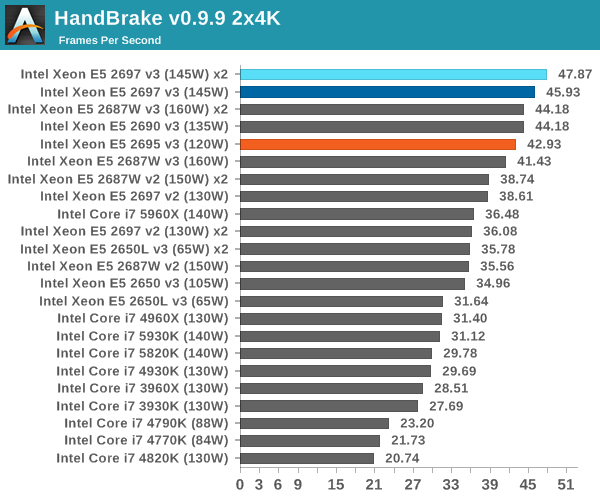
Dolphin Benchmark: link
Many emulators are often bound by single thread CPU performance, and general reports tended to suggest that Haswell provided a significant boost to emulator performance. This benchmark runs a Wii program that raytraces a complex 3D scene inside the Dolphin Wii emulator. Performance on this benchmark is a good proxy of the speed of Dolphin CPU emulation, which is an intensive single core task using most aspects of a CPU. Results are given in minutes, where the Wii itself scores 17.53 minutes.
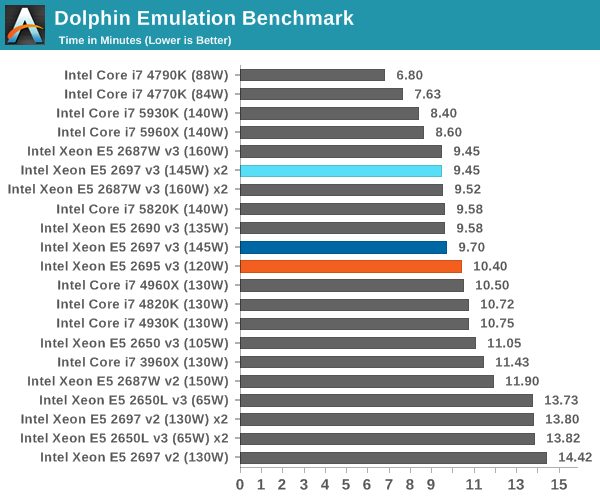
WinRAR 5.0.1: link
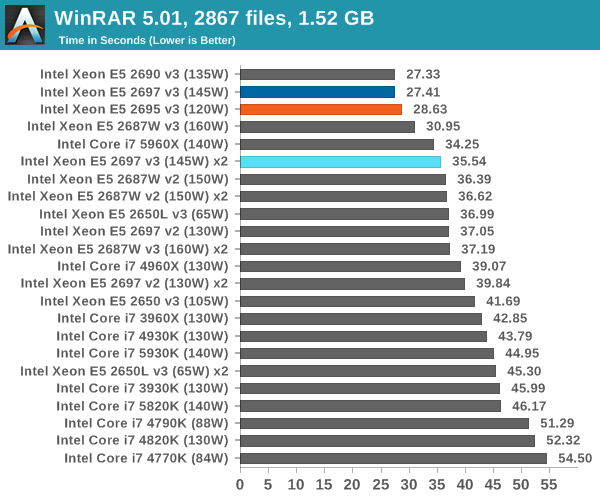
PCMark8 v2 OpenCL
A new addition to our CPU testing suite is PCMark8 v2, where we test the Work 2.0 and Creative 3.0 suites in OpenCL mode.
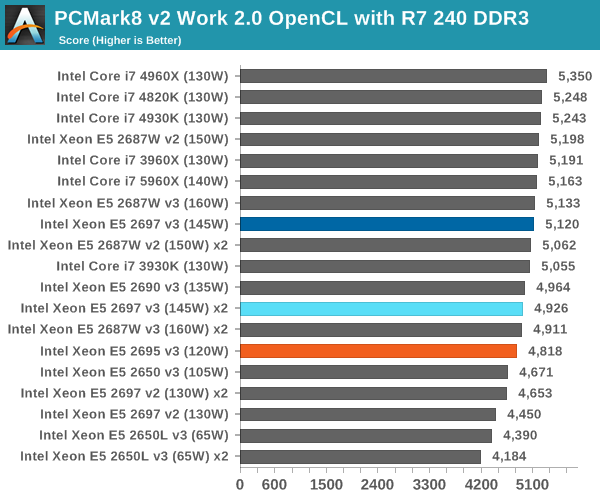
Hybrid x265
Hybrid is a new benchmark, where we take a 4K 1500 frame video and convert it into an x265 format without audio. Results are given in frames per second.
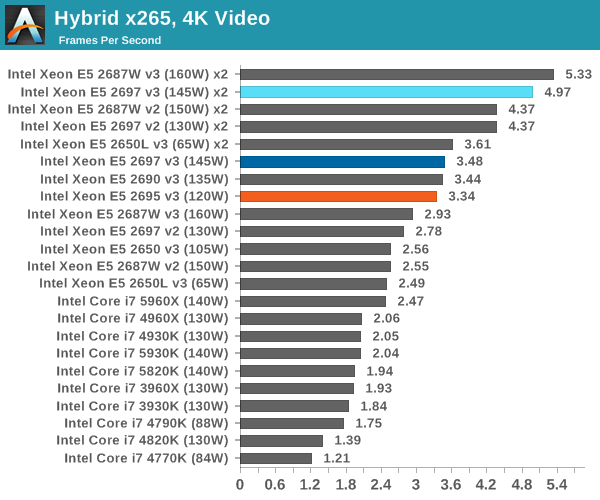
3D Particle Movement
3DPM is a self-penned benchmark, taking basic 3D movement algorithms used in Brownian Motion simulations and testing them for speed. High floating point performance, MHz and IPC wins in the single thread version, whereas the multithread version has to handle the threads and loves more cores.
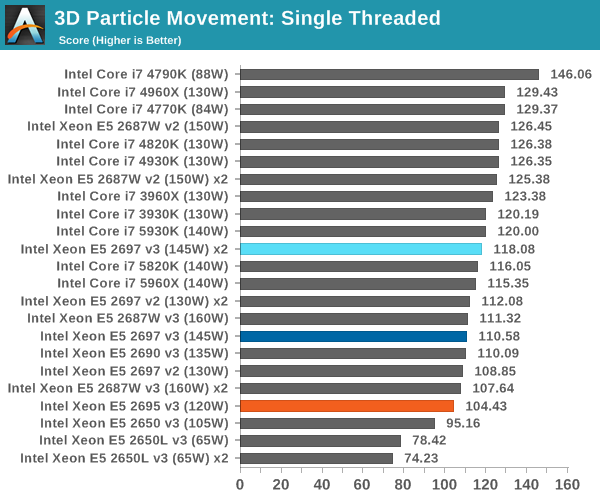
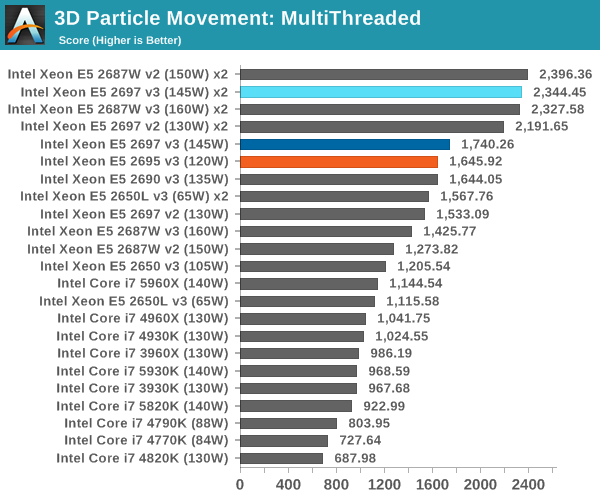
FastStone Image Viewer 4.9
FastStone is the program I use to perform quick or bulk actions on images, such as resizing, adjusting for color and cropping. In our test we take a series of 170 images in various sizes and formats and convert them all into 640x480 .gif files, maintaining the aspect ratio. FastStone does not use multithreading for this test, and results are given in seconds.

Web Benchmarks
On the lower end processors, general usability is a big factor of experience, especially as we move into the HTML5 era of web browsing. For our web benchmarks, we take four well known tests with Chrome 35 as a consistent browser.
Sunspider 1.0.2
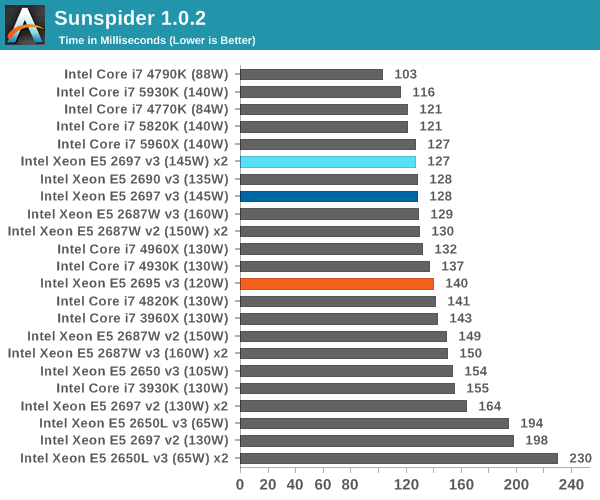
Mozilla Kraken 1.1

WebXPRT

Google Octane v2
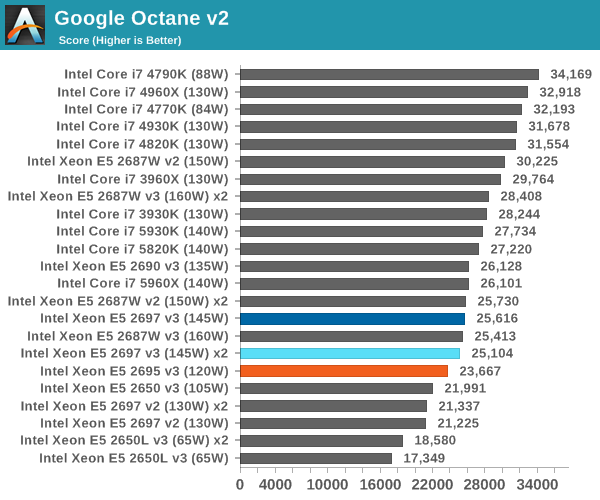










44 Comments
View All Comments
martinpw - Thursday, November 20, 2014 - link
Of interest - Intel did a custom version of the 2698 called the 2698A for Lenovo which pushes the base clock from 2.3 to 2.8GHz. It is water cooled.aka_Warlock - Thursday, November 20, 2014 - link
14 core gaming benchmarks!???!! Wtf?? Who the f*** cares?? Where are the virtualization benches??? Ffs... This is just too god damn poor.wallysb01 - Thursday, November 20, 2014 - link
And I’m pretty sure this has been a main complaint through out this whole E5-2600v3 review, but no action to fix it.SanX - Thursday, November 20, 2014 - link
You take 4790k overclicked to 5GHz and it will win most of single chip benchmarks lolname99 - Thursday, November 20, 2014 - link
"If it happens in a core as part of the logic or caches, that core can be fused off and the die can sold as a lower core part. This is how yields are improved, by reusing the dies that have errors in removable sections."Is this REALLY the case? We've heard this claim for years, but the only case I know of where it's actually been verified is when AMD was selling 3-core CPUs harvested from 4-core dies.
The reason I am dubious is that, if this is such a great system for increasing profits, how come the ONLY place it ever seems to be used is in Intel's server models?
POWER does not sell dies with random numbers of cores. (Or more precisely they talk about 6, 8, 10 and 12 processor variants but, as far as I can tell, each one of these is a separate die. Certainly they have showed the die shots for the 6 processor version.)
ARM does not do this. There are, as far as I know, no ARM phones that save a buck by using three cores harvested from a four core die, even though that would make sense for many markets and many use cases.
Even Intel does not do this outside Xeons. It's the same story as ARM --- given Intel's crazy market segmentation, again there'd certainly be a market for 3-core i7's harvested from 4-core i7's and priced appropriately.
looncraz - Friday, November 21, 2014 - link
From my understanding, some higher models with defects are binned to lower models even if specific dies exist for those lower models.For instance, it could be the case that some i3s are binned i5s, but it would probably be only a few percent of the total number of chips.
chekk - Thursday, November 20, 2014 - link
Power consumption delta is still undesirable. Please Ian, Ryan et al, go back to separate idle and load measurements.kordian - Friday, November 21, 2014 - link
Again, why are there no database scalability benchmarks or virtualization benchmarks? Redis is single-threaded, so of course a high-clocked desktop processor will win - it doesn't take advantage of the main strength of these processors - their huge number of cores. Can we please drop the gaming benchmarks on these and get some benchmarks that reflect the use of a 36 core dual socket box.antialienado - Friday, November 21, 2014 - link
This is an important idea that Anandtech should implement to differentiate itself and add value: Create an Anandtech designation for processors.It could be based on performance, and some common metrics, number of cores, , and many features, but it should be consistent between generations.
Today is easy to get lost. I lost track of many, many meaningless names. Haswell, Ivy Bridge, Sandy Bridge, Vishera, E5-2695 V3 means nothing to me. Too many generations, too many names, conveying too little information.
When I see an article title, saying E5-2697 V3, I don’t get a clue about if this is a portable processor, a desktop, bang for the buck, server, a top processor, review worth of my time, of just a random processor being reviewed just for the sake of making content.
Ok, the title on THIS article says at least that it is a 14 cores Xeon processor, but that is not the point. The point is that ANY article should be clear about what it does review. It does not matter if the title spoils the conclusion by telling the processor performance right on the title. I want information, not a mystery story. The article will explain why it got the designation it got.
There are many dimensions explaining the performance of each processor. Single threaded performance, multi threaded, energy efficient, portable at notebook level, or at tablet/phone level, locked/unlocked, gaming, office, server, workstation, socket compatibility, GPU integrated, etc.
But processor naming make little or no attempt to clarify any of those variables.
I would prefer sockets being referred by year of introduction, features, type of memory, etc; not by another meaningless jungle naming. I already lost track of soo many designations, and each year it gets worse, more varied and confusing.
Anandtech already haves some classifications on GPU and processors based on similar performing. It should be converted into an Anandtech rating, for clarity.
Anandtech should create a naming scheme not making a difference between AMD and Intel when it does not matter (like on performance).
Of course, it would necessarily have unavoidable flaws, but any system would be better that the official naming, and lack of coherency between generations and manufacturer.
Maybe other sites start adopting Anandtech designation.
dave1231 - Friday, November 21, 2014 - link
$0.10 per kwh? Try $0.28 per kWh in the UK then nearly triple the running costs. This is why we are so much better at not global warming.